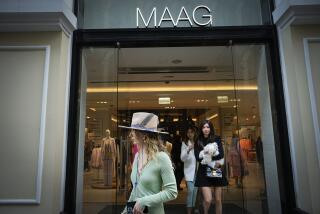Regional Outlook : Decay Behind a ‘Silver Curtain’ : The Wall may have fallen, but poverty still separates Eastern Europe from the West. Without more trade, the future looks grim.
- Share via
KACZEWO, Poland — The dairy cases of Poland’s grocery stores are stocked high with butter from Germany and the Netherlands--so high that native son Brunon Wardecki, who owns 13 black-and-white cows, cannot profitably sell butter even to his local market.
And he doesn’t stand a chance of selling it in Western Europe. Dairy farmers there receive huge government handouts, allowing them to undersell their Eastern European competition. Besides, for the most part, Wardecki and his compatriots simply don’t produce food that is sufficiently appealing and clean for Western European tastes.
It is a paradox of the new Europe: Although poverty-stricken Eastern Europe desperately needs to find new markets in the West, it is instead Western European exporters, frequently, who are prospering from the development of free-market economies in the East.
At stake is more than just the welfare of the woebegone former Soviet satellites. If Eastern Europeans cannot create a little Western prosperity in their own countries, they will seek it instead by flooding into the West--not only Western Europe but also that traditional haven, the United States. This was Polish President Lech Walesa’s implicit threat when he warned last year that the Iron Curtain must not be replaced by a “silver curtain separating a rich West from a poor East.”
Europe’s economic divide may not finally be bridged until Eastern Europe’s fledgling democracies become part of the European Community, which is now home to most of Western Europe’s mightiest economic powers.
The “association agreements” signed last year by the EC and Poland, Czechoslovakia and Hungary declare EC membership to be the ultimate objective of those three countries. Eastern Europeans talk fondly of joining the EC in about a decade, once their democratic governments are firmly rooted, their free markets are functioning and their prosperity rises at least to the levels of EC members Portugal and Greece.
But the accords do not commit the EC to that goal--an omission that Richard Portes, director of London’s Center for Economic Policy Research, calls potentially fatal for the East-West relationship.
Instead, the agreements gradually aim to create a free-trade area between West and East (agriculture excluded) after 10 years. But even here, economist L. Alan Winters of Britain’s University of Birmingham says the accords’ fine print, by protecting farmers and other Western European special interests, “threatens the recovery of the (Eastern European) economies and ultimately even their reform programs.”
Since throwing off the Communist yoke in 1989, Poland and its neighbors have gone into sickening economic tailspins. Trade, even more than direct financial aid, is everyone’s favorite solution; by buying Eastern goods, the West can help Eastern Europe pull itself up by its own bootstraps.
“We aren’t asking for money,” says Ladislav Valasek, a Czech trade negotiator with the European Community. “We want opportunity.”
They are getting a little. Eastern Europe is selling more to its Western European neighbors than ever before; exports have roughly doubled since the 1989 revolutions.
But that isn’t saying much, since trade had been so low before. And imports are also up--the EC actually enjoyed a small trade surplus with Eastern Europe last year.
The causes for limited trade can be found on both sides of Walesa’s silver curtain.
The West is loath to open up markets--particularly in farm goods, textiles and steel--in which its own producers are already struggling. From French farmers to Spanish steelmakers, Western Europe’s special interests are warning of unfair competition from countries where industries are heavily government-subsidized (never mind the massive subsidies that prevail in the EC) and wages remain relatively low.
But it is not only the West that is responsible for the East’s difficulties. In the third year of its economic revolution, Eastern Europe is still struggling to find formulas for producing, transporting and marketing what Western Europe wants to buy.
Farmers must meet Western sanitary standards and sell their products more effectively--a buyer for a Belgian grocery chain says Eastern European exporters neglect even to carry samples of their goods. Manufacturers must also bring their goods up to snuff. Most Eastern European textile plants, to take one example, make little that anyone in the West wants to wear.
Here in Poland’s dairy belt, Wardecki, 74, has surmounted some of these obstacles. The dairy farmer--whose living-room wall features a painting of his father on horseback killing a Bolshevik soldier during the 1920 war with the Soviet Union--says his operation, unlike many in Poland, exceeds the EC’s standards for cleanliness. Most of Wardecki’s milk is made into powder and sold in Latin America.
But much to his frustration, he can’t compete with Western European butter.
“It’s not fair, but we have no defense against it,” he complains. “Our government can’t afford to subsidize us the way the EC can. So the EC butter comes in at cheap prices and wrecks our market.”
A little comparison shopping shows what he means. At a state-run market on the outskirts of Warsaw, for example, Polish butter sells for the equivalent of $1.15 a pound. Butter from the Netherlands, 700 miles away, where dairy farmers earn more than Polish farmers ever dreamed of, goes for only $1.10.
When the Warsaw government engineered Poland’s overnight transition to a free-market economy on Jan. 1, 1990, it virtually abolished tariffs on farm imports, making the country’s agricultural market one of the most open in the world. Polish livestock farmers, faced with a serious reduction in demand, cut back the size of their herds, which they have only begun to build back up since the government instituted some new tariffs last summer.
The EC, meanwhile, has scarcely reduced its tariffs on Eastern European farm products at all, despite the association agreements that Poland, Czechoslovakia and Hungary signed with the EC last year.
Consider this example. Before the agreements took hold, the EC had allowed Hungary to sell a mere 11,000 tons of beef a year before applying tariffs that priced Hungarian beef out of the EC’s gigantic 6-million-ton market. The association agreements will increase that level by only 1,100 tons a year for five years--”a few drops in the ocean,” according to Chris Horseman, a British agricultural analyst.
But trade policies alone do not account for Eastern Europe’s inability to place its goods on EC grocery shelves. Poland and its neighbors have problems of their own.
One is quality. “We tried once to sell Polish cornflakes in Germany,” says an executive of a Polish grain trader, “but they would not accept such quality. We don’t have the means to compete with Kellogg’s and Quaker Oats.”
For Eastern Europe, one shortcut to quality is investment by Western food processors. When Gerber Products, America’s leading baby-food company, bought Poland’s biggest fruit-juice maker, for example, one of its purposes was to gain access to the EC market, which it had barely dented from across the Atlantic.
Even when the quality of Eastern Europe’s goods is not an obstacle, capacity can be. Warsaw’s Wola dairy, one of the country’s biggest, has begun turning out milk every bit as good as that available in Western Europe.
But “we can easily sell all we make right here,” says Wola Vice President Andrzej Kaczorowski. “There’s nothing left over to export.”
Then there are those marketing shortcomings.
So far, complains Emanuel Tonglet, a buyer for Belgium’s Delhaize supermarket chain, Eastern European exporters offer only huge quantities of single products, forcing heavy storage costs on Western importers. “With exporters from northern France we have diversified our imports,” he says, “allowing for smaller quantities per product at almost no storage costs.”
Jean Delvaux, who buys for a consortium of Western supermarkets called Eurogroup, complains that Eastern European managers have not forgotten the bad habits they learned under communism.
“Their main objective is to maintain production and keep a maximum number of their friends employed,” Delvaux says. “Sadly, they show no initiative. If we want to import more frozen vegetables, we are the ones who have to make the approach.”
Compared to farm goods, Western Europe’s markets for Eastern European steel are wide open. The association agreements abolished previous quotas.
But at the insistence of the Spanish, the agreements also include “safeguard” clauses allowing the EC to block Eastern imports if they “threaten” Western markets.
The EC, fearing to roil the political waters, has not yet invoked the safeguard clauses. So the Western European steel industry and the governments of Germany and France are seeking a different sort of remedy, filing complaints charging the Eastern Europeans with “dumping” their steel in Western Europe at prices below what they charge at home. If the EC’s Executive Commission finds that the complaints have merit, it can impose duties on the Eastern European steel.
Ruprecht Vondran, president of the German Steel Federation, says Eastern European governments continue to subsidize the energy and transportation costs of their steel industries. As a result, he says, Eastern Europe can undercut Western manufacturers’ prices by 20% to 35%.
“Those prices are destroying the European market,” protests the German federation’s spokeswoman.
Steel exports from Eastern Europe to the EC soared by nearly 50% in the first two months of this year, compared to the same period of 1991. But not all potential customers are buying.
Volkswagen, for one, still puts no Eastern European steel into its cars. “It’s not a question of price,” said a Volkswagen spokesman. “The quality we need is not the quality they can deliver.”
In textiles even more than in steel, quality is an issue. The “Made in Poland” label is not a strong selling point in the EC.
The association agreements with Poland, Czechoslovakia and Hungary will phase out EC textile quotas over five years. But Western textile interests are already on guard.
“It is a menace for us,” says Camille Blum, director general of Comitextile, a Western European industry association.
Maybe in the future. But last year Hungary was able to export only 25% of its quota to the EC; Poland could do no better than 39%.
Guy Arnould, secretary general of Europe’s Largest Textile and Apparel Companies, thinks he knows why. Between 1982 and 1990, he says, Eastern Europe replaced only 30% of its textile manufacturing equipment. In Western Europe the figure was 135%; more than one-third of the equipment was replaced twice.
In fact, about half of Eastern Europe’s textile exports to the EC consist of apparel assembled in the East from fabric shipped from the West. That gives Western Europe the best of both worlds: its own high-quality material, turned into clothing by textile workers who earn as little as 3% of Western wages.
It is Eastern Europe’s goal to close these gaps. It has a long way to go--and a lot of resistance to overcome.
“We are in a tunnel,” says Valasek, the Czech trade negotiator. “At the end of the tunnel is a light, and the light is integration with the European Community.”
Times researcher Isabelle Maelcamp contributed to this story from Brussels.
A Small Shot in the Arm
Export sales to European Community and United States(in millions of U.S. dollars)
Poland, Czechoslovakia and Hungary are exporting more goods, but their economies remain anemic. There are many barriers to trade:
* The West doesn’t want to open up its markets.
* E.C. tariffs remain high.
* Eastern European products are often inferior to Western ones.
* The Formerly Communist economies are inexperienced in marketing.
Sales to the U.S.:
Poland:
1990: $410
1991: $360
Czechoslovakia:
1990: 80
1991: 140
Hungary:
1990: 350
1991: 370
Sales to the E.C.
Poland:
1990: $7,800
1991: $6,700
Czechoslovakia:
1990: 3,400
1991: 5,100
Hungary:
1990: 3,900
1991: 4,600
Source: Organization for Economic Cooperation and Development
More to Read
Sign up for Essential California
The most important California stories and recommendations in your inbox every morning.
You may occasionally receive promotional content from the Los Angeles Times.













